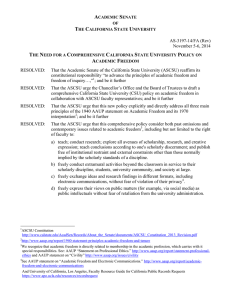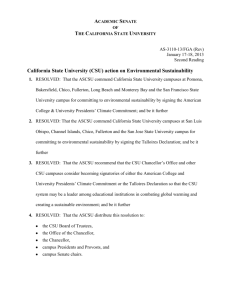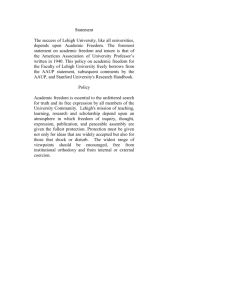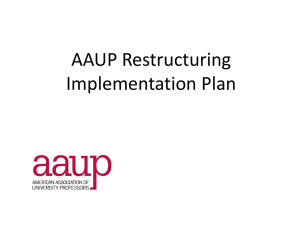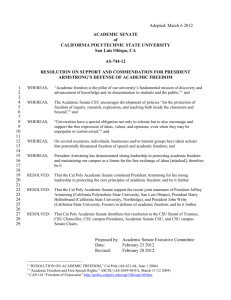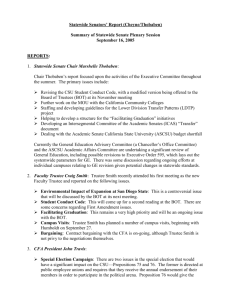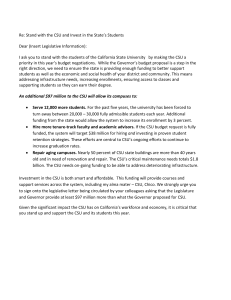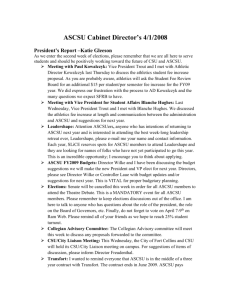AS 3197-14 Resolution
advertisement
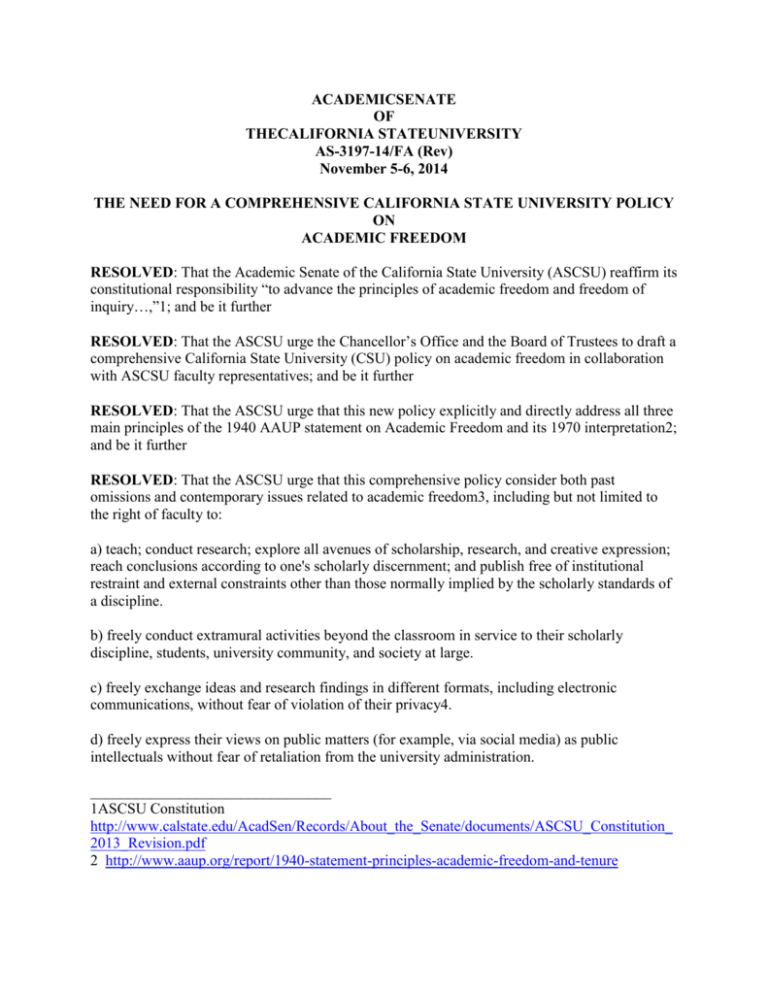
ACADEMICSENATE OF THECALIFORNIA STATEUNIVERSITY AS-3197-14/FA (Rev) November 5-6, 2014 THE NEED FOR A COMPREHENSIVE CALIFORNIA STATE UNIVERSITY POLICY ON ACADEMIC FREEDOM RESOLVED: That the Academic Senate of the California State University (ASCSU) reaffirm its constitutional responsibility “to advance the principles of academic freedom and freedom of inquiry…,”1; and be it further RESOLVED: That the ASCSU urge the Chancellor’s Office and the Board of Trustees to draft a comprehensive California State University (CSU) policy on academic freedom in collaboration with ASCSU faculty representatives; and be it further RESOLVED: That the ASCSU urge that this new policy explicitly and directly address all three main principles of the 1940 AAUP statement on Academic Freedom and its 1970 interpretation2; and be it further RESOLVED: That the ASCSU urge that this comprehensive policy consider both past omissions and contemporary issues related to academic freedom3, including but not limited to the right of faculty to: a) teach; conduct research; explore all avenues of scholarship, research, and creative expression; reach conclusions according to one's scholarly discernment; and publish free of institutional restraint and external constraints other than those normally implied by the scholarly standards of a discipline. b) freely conduct extramural activities beyond the classroom in service to their scholarly discipline, students, university community, and society at large. c) freely exchange ideas and research findings in different formats, including electronic communications, without fear of violation of their privacy4. d) freely express their views on public matters (for example, via social media) as public intellectuals without fear of retaliation from the university administration. ________________________________ 1ASCSU Constitution http://www.calstate.edu/AcadSen/Records/About_the_Senate/documents/ASCSU_Constitution_ 2013_Revision.pdf 2 http://www.aaup.org/report/1940-statement-principles-academic-freedom-and-tenure 3We recognize that academic freedom is directly related to membership in the academic profession, which carries with it special responsibilities. See: AAUP “Statement on Professional Ethics.” http://www.aaup.org/report/statement-professional-ethics and AAUP statement on “Civility” http://www.aaup.org/issues/civility 4See AAUP statement on “Academic Freedom and Electronic Communications.” http://www.aaup.org/report/academic-freedom-and-electronic-communications And University of California, Los Angeles, Faculty Resource Guide for California Public Records Requests https://www.apo.ucla.edu/resources/recordrequest e) address any matter of institutional policy or action whether or not as a member of an agency of institutional governance5. f) ensure the full protections of the Constitution of the United States, the Constitution of the State of California, and the CSU mission; and be it further RESOLVED: That the ASCSU distribute this resolution to the CSU Board of Trustees, CSU Chancellor, CSU campus Presidents, CSU campus Senate Chairs, CSU Provosts/Vice Presidents of Academic Affairs, California Faculty Association, CSU Emeritus and Retired Faculty Association, California State Student Association, American Association of University Professors. RATIONALE: The last formal statement on academic freedom for the California State University, formulated in 1971, reads: “a. The teacher is entitled to full freedom in teaching and in the publication of the results, subject to adequate performance of other academic duties; but research for pecuniary return should be upon an understanding with the authorities of the institution. b. The teacher is entitled to freedom in the classroom in discussing any subject, but he should be careful not to introduce into his teaching controversial matter which has no relation to his subject.” Apart from the datedness of the masculine pronoun, the 1971 policy demands rethinking in light of the many developments over the last 40 years that have both broadened the scope of academic work and responsibilities and redefined the public expectations of what a university is and does. It also warrants rethinking in terms of the challenges to academic freedom faced by the CSU and its faculty. Some of the developments that have broadened the scope of academic work and responsibilities include: ● the global expansion of higher education; ● developments in communication technology that enable, and in fact encourage, scholars and students to function within global professional, research, and civic networks; ● the broader expectations attendant on academic scholars in their role as “public intellectuals” (with accompanying pressures that bear on their behavior and pronouncements inside as well as, and especially, outside of the classroom); and 5AAUP statement: “Protecting an Independent Faculty Voice: Academic Freedom after Garcetti v. Ceballos” http://www.aaup.org/report/protecting-independent-faculty-voice-academicfreedom-after-garcetti-v-ceballos University of Oregon http://policies.uoregon.edu/node/218 University of Wisconsin http://www.secfac.wisc.edu/senate/2010/0301/2186.pdf University of Minnesota http://regents.umn.edu/sites/regents.umn.edu/files/policies/Academic_Freedom.pdf University of California http://regents.universityofcalifornia.edu/aar/jule.pdf ● the expansion of international programs and scholarly and student exchanges, with the concomitant potential for geopolitical pressures on universities and faculty. In addition, public expectations regarding the nature and role of the university itself have evolved significantly over the last 40 years. The expansion of expectations of a large public university such as the CSU--from a community of teachers and students to a complex institution functioning at the intersection of diverse worlds, interests, and investments (intellectual, economic, social, political, as well as local, regional, national, and global in scope)--opens the university as well as its faculty to intensified scrutiny and potential interference from a wide variety of quarters and in pursuit of a variety of agendas. The 1940 AAUP policy, reaffirmed in 1970, includes three components, the first two are reflected directly in the CSU policy, but the following component is not explicitly addressed: College and university teachers are citizens, members of a learned profession, and officers of an educational institution. When they speak or write as citizens, they should be free from institutional censorship or discipline, but their special position in the community imposes special obligations. As scholars and educational officers, they should remember that the public may judge their profession and their institution by their utterances. Hence they should at all times be accurate, should exercise appropriate restraint, should show respect for the opinions of others, and should make every effort to indicate that they are not speaking for the institution.6 The 1971 CSU policy is too limited in scope to deal with potential challenges presented by activities such as faculty’s participation in extramural pursuits beyond the classroom, faculty’s use of electronic communications, faculty’s public expressions via social media, faculty’s role in shared governance, or external requests for access to faculty electronic communications. The lack of a clear policy has the dangerous potential of faculty self-censorship. The lack of a comprehensive policy on academic freedom has left CSU faculty at the mercy of different interpretations and implementations of the principles of academic freedom. The CSU cannot afford to have a policy on Academic Freedom that is insufficient for the 21st century. The mission of the institutions of higher education is serving society by discovering, investigating, communicating, and preserving knowledge by educating students and the larger society. This mission cannot be fulfilled without freedom of teaching, research, and communication inside and outside of the classroom. In summary, the wording and content of the policy is outdated and insufficient, as the nature of academic activity has changed. Our policy should be regularly reviewed and, if needed, revised to reflect such changes, as is done by other major universities7. We want to be proactive, updating the policy to reflect best practices and address components of academia in the 21st century. As the largest public university system in the United States, the CSU is often a leader in higher education, but our current policy is behind the times, as it does not fully reflect the content of the 1940 AAUP statement nor advancements in area of academic freedom since then. 6 http://www.aaup.org/report/1940-statement-principles-academic-freedom-and-tenure Approved – January 23, 2015 7Some examples of best practices could be found at: University of Oregon http://policies.uoregon.edu/node/218 University of Wisconsin http://www.secfac.wisc.edu/senate/2010/0301/2186.pdf University of Minnesota http://regents.umn.edu/sites/regents.umn.edu/files/policies/Academic_Freedom.pdf University of California http://regents.universityofcalifornia.edu/aar/jule.pdf
